instrument panel FIAT TALENTO 2017 Owner handbook (in English)
[x] Cancel search | Manufacturer: FIAT, Model Year: 2017, Model line: TALENTO, Model: FIAT TALENTO 2017Pages: 228, PDF Size: 4.47 MB
Page 147 of 228
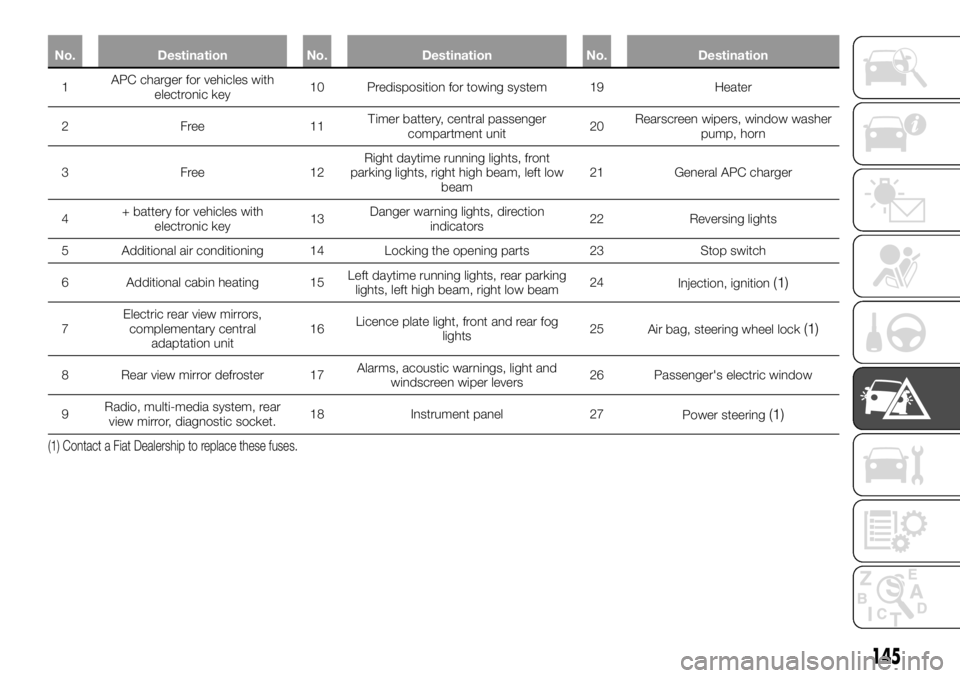
No. Destination No. Destination No. Destination
1APCcharger for vehicles with
electronic key10 Predisposition for towing system 19 Heater
2Free11Timer battery, central passenger
compartment unit20Rearscreen wipers, window washer
pump, horn
3Free12Right daytime running lights, front
parking lights, right high beam, left low
beam21 General APC charger
4+ battery for vehicles with
electronic key13Danger warning lights, direction
indicators22 Reversing lights
5 Additional air conditioning 14 Locking the opening parts 23 Stop switch
6 Additional cabin heating 15Left daytime running lights, rear parking
lights, left high beam, right low beam24
Injection, ignition
(1)
7Electric rear view mirrors,
complementary central
adaptation unit16Licence plate light, front and rear fog
lights25
Air bag, steering wheel lock(1)
8 Rear view mirror defroster 17Alarms, acoustic warnings, light and
windscreen wiper levers26 Passenger's electric window
9Radio, multi-media system, rear
view mirror, diagnostic socket.18 Instrument panel 27
Power steering
(1)
(1) Contact a Fiat Dealership to replace these fuses.
145
Page 160 of 228
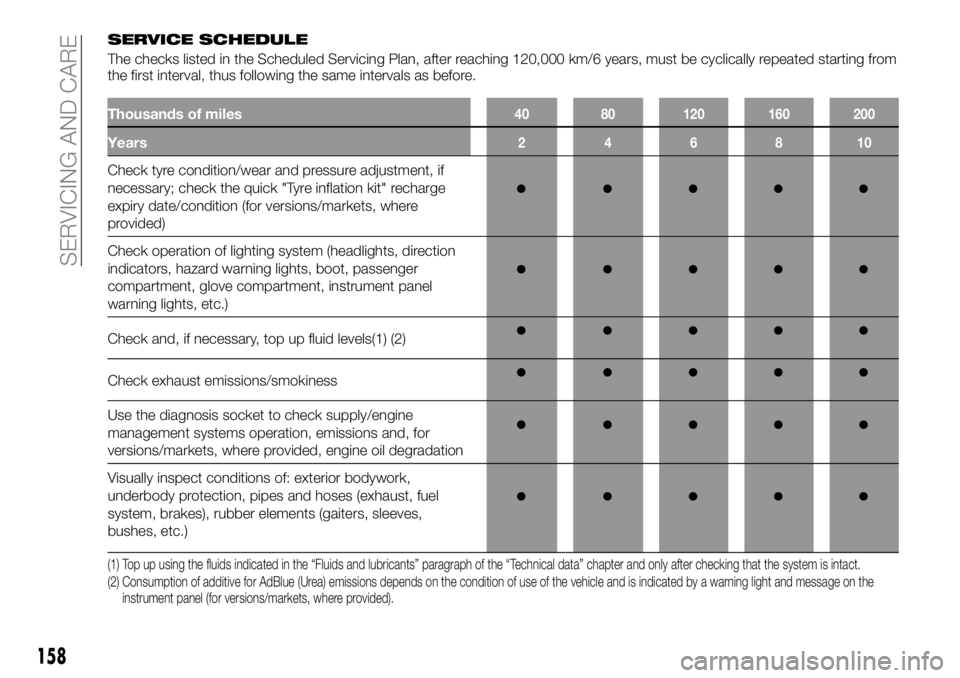
SERVICE SCHEDULE
The checks listed in the Scheduled Servicing Plan, after reaching 120,000 km/6 years, must be cyclically repeated starting from
the first interval, thus following the same intervals as before.
Thousands of miles40 80 120 160 200
Years246810
Check tyre condition/wear and pressure adjustment, if
necessary; check the quick "Tyre inflation kit" recharge
expiry date/condition (for versions/markets, where
provided)
Check operation of lighting system (headlights, direction
indicators, hazard warning lights, boot, passenger
compartment, glove compartment, instrument panel
warning lights, etc.)
Check and, if necessary, top up fluid levels(1) (2)
Check exhaust emissions/smokiness
Use the diagnosis socket to check supply/engine
management systems operation, emissions and, for
versions/markets, where provided, engine oil degradation
Visually inspect conditions of: exterior bodywork,
underbody protection, pipes and hoses (exhaust, fuel
system, brakes), rubber elements (gaiters, sleeves,
bushes, etc.)
(1) Top up using the fluids indicated in the “Fluids and lubricants” paragraph of the “Technical data” chapter and only after checking that the system is intact.
(2) Consumption of additive for AdBlue (Urea) emissions depends on the condition of use of the vehicle and is indicated by a warning light and message onthe
instrument panel (for versions/markets, where provided).
158
SERVICING AND CARE
Page 161 of 228
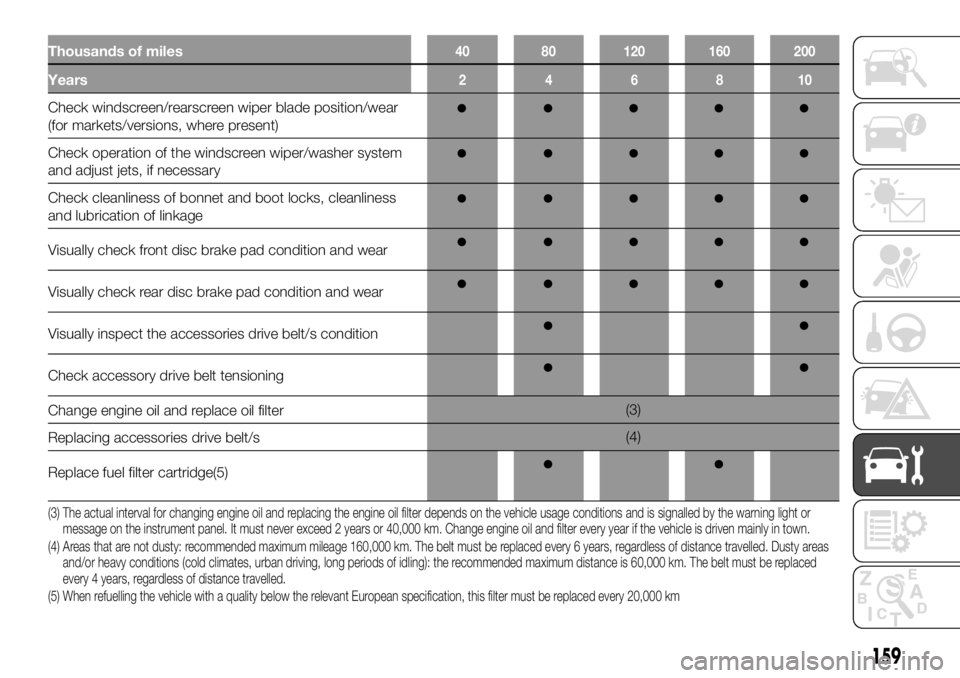
Thousands of miles40 80 120 160 200
Years246810
Check windscreen/rearscreen wiper blade position/wear
(for markets/versions, where present)
Check operation of the windscreen wiper/washer system
and adjust jets, if necessary
Check cleanliness of bonnet and boot locks, cleanliness
and lubrication of linkage
Visually check front disc brake pad condition and wear
Visually check rear disc brake pad condition and wear
Visually inspect the accessories drive belt/s condition
Check accessory drive belt tensioning
Change engine oil and replace oil filter(3)
Replacing accessories drive belt/s(4)
Replace fuel filter cartridge(5)
(3) The actual interval for changing engine oil and replacing the engine oil filter depends on the vehicle usage conditions and is signalled by the warning light or
message on the instrument panel. It must never exceed 2 years or 40,000 km. Change engine oil and filter every year if the vehicle is driven mainly in town.
(4) Areas that are not dusty: recommended maximum mileage 160,000 km. The belt must be replaced every 6 years, regardless of distance travelled. Dustyareas
and/or heavy conditions (cold climates, urban driving, long periods of idling): the recommended maximum distance is 60,000 km. The belt must be replaced
every 4 years, regardless of distance travelled.
(5) When refuelling the vehicle with a quality below the relevant European specification, this filter must be replaced every 20,000 km
159
Page 165 of 228
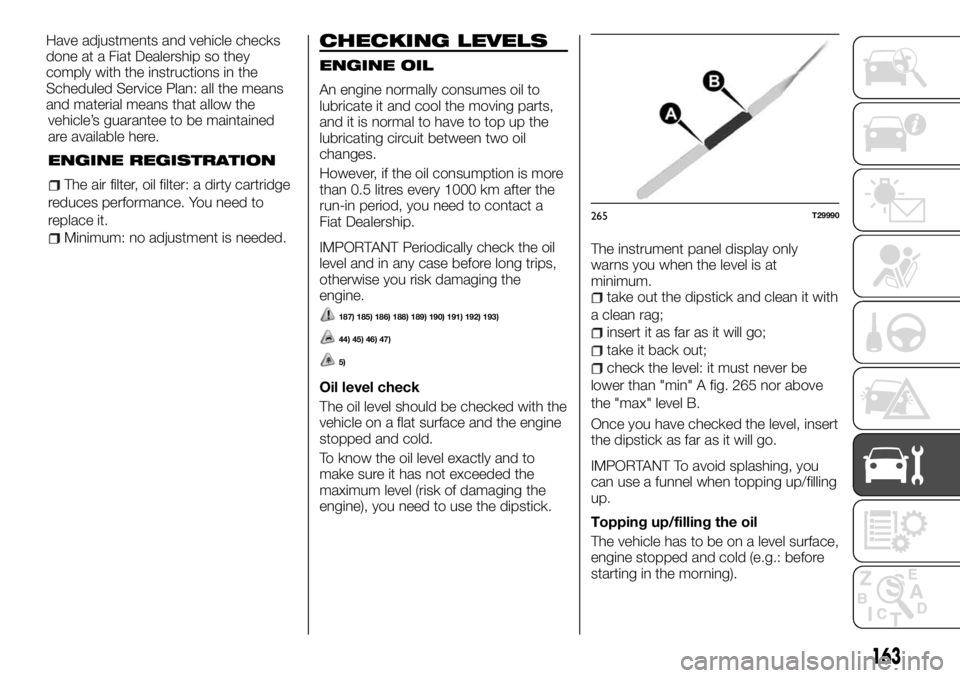
vehicle’s guarantee to be maintained
are available here.
ENGINE REGISTRATION
The air filter, oil filter: a dirty cartridge
reduces performance. You need to
replace it.
Minimum: no adjustment is needed.
CHECKING LEVELS
ENGINE OIL
An engine normally consumes oil to
lubricate it and cool the moving parts,
and it is normal to have to top up the
lubricating circuit between two oil
changes.
However, if the oil consumption is more
than 0.5 litres every 1000 km after the
run-in period, you need to contact a
Fiat Dealership.
IMPORTANT Periodically check the oil
level and in any case before long trips,
otherwise you risk damaging the
engine.
187) 185) 186) 188) 189) 190) 191) 192) 193)
44) 45) 46) 47)
5)
Oil level check
The oil level should be checked with the
vehicle on a flat surface and the engine
stopped and cold.
To know the oil level exactly and to
make sure it has not exceeded the
maximum level (risk of damaging the
engine), you need to use the dipstick.The instrument panel display only
warns you when the level is at
minimum.
take out the dipstick and clean it with
a clean rag;
insert it as far as it will go;
take it back out;
check the level: it must never be
lower than "min" A fig. 265 nor above
the "max" level B.
Once you have checked the level, insert
the dipstick as far as it will go.
IMPORTANT To avoid splashing, you
can use a funnel when topping up/filling
up.
Topping up/filling the oil
The vehicle has to be on a level surface,
engine stopped and cold (e.g.: before
starting in the morning).
265T29990
163
Have adjustments and vehicle checks
done at a Fiat Dealership so they
comply with the instructions in the
Scheduled Service Plan: all the means
and material means that allow the
Page 170 of 228
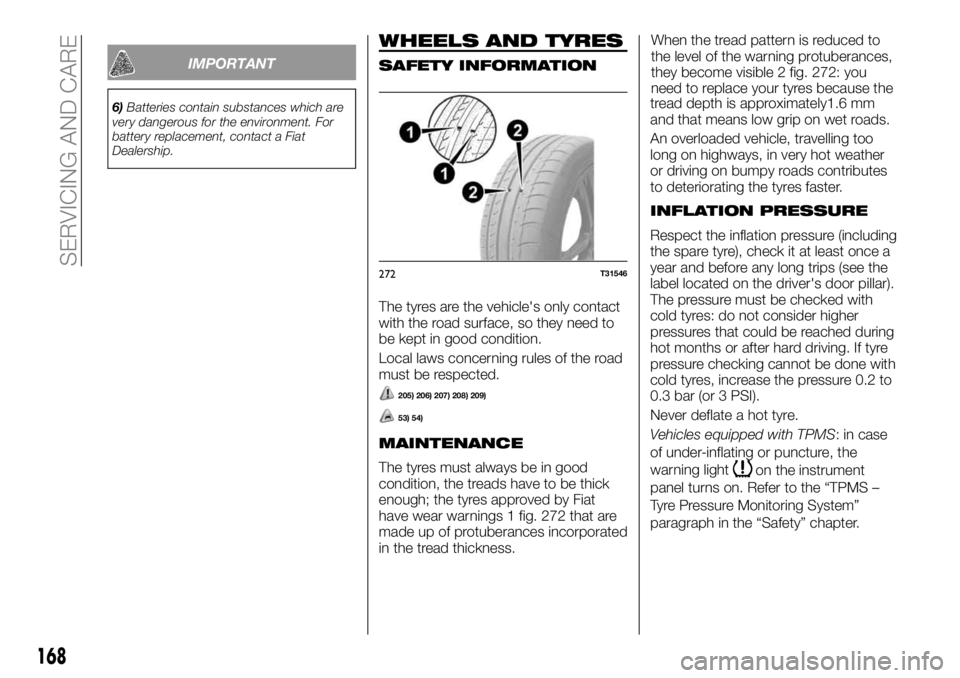
IMPORTANT
6)Batteries contain substances which are
very dangerous for the environment. For
battery replacement, contact a Fiat
Dealership.
WHEELS AND TYRES
SAFETY INFORMATION
The tyres are the vehicle's only contact
with the road surface, so they need to
be kept in good condition.
Local laws concerning rules of the road
must be respected.
205) 206) 207) 208) 209)
53) 54)
MAINTENANCE
The tyres must always be in good
condition, the treads have to be thick
enough; the tyres approved by Fiat
have wear warnings 1 fig. 272 that are
made up of protuberances incorporated
in the tread thickness.When the tread pattern is reduced to
the level of the warning protuberances,
they become visible 2 fig. 272: you
need to replace your tyres because the
tread depth is approximately1.6 mm
and that means low grip on wet roads.
An overloaded vehicle, travelling too
long on highways, in very hot weather
or driving on bumpy roads contributes
to deteriorating the tyres faster.
INFLATION PRESSURE
Respect the inflation pressure (including
the spare tyre), check it at least once a
year and before any long trips (see the
label located on the driver's door pillar).
The pressure must be checked with
cold tyres: do not consider higher
pressures that could be reached during
hot months or after hard driving. If tyre
pressure checking cannot be done with
cold tyres, increase the pressure 0.2 to
0.3 bar (or 3 PSI).
Never deflate a hot tyre.
Vehicles equipped with TPMS: in case
of under-inflating or puncture, the
warning light
on the instrument
panel turns on. Refer to the “TPMS –
Tyre Pressure Monitoring System”
paragraph in the “Safety” chapter.
272T31546
168
SERVICING AND CARE
Page 175 of 228

What to do
Wash the car by hand, with lots of
water, using a soft cloth or sponge.
Going through an automatic car
wash
Bring the windscreen wiper to the stop
position (refer to the "Windscreen /
Rearscreen wiper” paragraph in the
"Getting to know your vehicle” chapter).
Check that external equipment is fixed
properly (additional lamps, rearview
mirrors) and remove the radio aerial (for
versions/markets where provided).
Headlight cleaning
Since the headlights are equipped with
plastic materials, use a soft cloth or
cotton pad. If this is not sufficient, wet it
slightly with soapy water, then rinse with
a soft cloth or cotton. Finish by drying
delicately with a soft, dry cloth. Do not
use alcohol-based products.
Windows
(e.g.: the instrument panel, clock,
outside temperature display panel,
radio display panel, multi-media or
multi-function display panel, etc.)
Use a soft, cotton cloth. If this is not
sufficient, use a soft cloth (or a cotton
pad) slightly wetted with soapy water,
then rinse with a soft cloth or wet
cotton.
Finish by drying delicately with a soft,
dry cloth.
Do not use alcohol-based productsand/or nebulisers on the area.
WARNING
210)In order to preserve the aesthetic
appearance of the paint, abrasive products
and/or polishes should not be used for
cleaning the vehicle.
211)Avoid washing with rollers and/or
brushes in washing stations. Wash the
vehicle only by hand using neutral pH
detergents; dry it with a dampened
chamois leather. Abrasive products and/or
polishes should not be used for cleaning
the vehicle. Bird droppings must be
washed off immediately and thoroughly as
the acid they contain is particularly
aggressive. Avoid (if at all possible) parking
the vehicle under trees; remove vegetable
resins immediately as, when dried, it may
only be possible to remove them with
abrasive products and/or polishes, which is
highly inadvisable as they could alter the
typical opaqueness of the paint. Do not
use pure windscreen washer fluid for
cleaning the front windscreen and rear
window; dilute it min. 50% with water. Only
use pure screen washer fluid when strictly
necessary due to outside temperature
conditions.
IMPORTANT
7)Detergents pollute the environment. The
vehicle should be washed in areas
equipped for collecting and purifying the
liquid used in the washing process.
INTERIOR
212) 213) 214)
62) 63)
If it undergoes correct service, the
vehicle can last longer. Therefore, we
advise you to regularly see to servicing
the interior of your vehicle.
Every spot must be seen to promptly.
Whatever caused the stain, use cold,
soapy water (possibly warm) based on
mild soap.
Detergents are prohibited (liquid
detergent for dishes, powdered
detergent, alcohol-based products).
Use a soft cloth.
Rinse and blot the excess water.
Fabric (seats, door coverings, etc.)
Dust the fabric regularly.
Liquid spots
Use soapy water.
Blot lightly (without rubbing) with a soft
cloth, then rinse and remove residual
liquid.
Solid or pasty spots
Immediately and delicately remove the
excess solid or pasty material with a
spatula (working from the edges to the
middle, keeping the spot from growing).
Clean as indicated for liquid spots.
Special procedure for candy,
chewing gum
Apply an ice cube to crystalise it, then
proceed as indicated for solid spots.
173
Page 176 of 228

IMPORTANT For any interior service
advice or in case of unsatisfactory
results, see a Fiat Dealership.
Dismounting/remounting
removable equipment original to
the vehicle
If you need to remove original
equipment from the passenger
compartment (for example, mats) in
order to clean it, be sure to replace
them carefully on the correct side (the
driver's mat goes on the driver's side)
and fasten them using the components
supplied with them (for example, the
driver's mat must be held in place with
the standard fastening elements).
In any case, when the vehicle is
stopped, make sure nothing can
interfere with driving (impedes use of
the pedals: a heel that catches on the
mat, etc.).
What not to do
Placing objects where the diffusers are,
such as deodorants, air fresheners,
etc., that could damage the dashboard
trim.
WARNING
212)Never use flammable products, such
as petrol ether or rectified petrol to clean
the inside of the vehicle. The electrostatic
charges which are generated by rubbing
during the cleaning operation may cause a
fire.213)Do not keep aerosol cans in the
vehicle: they might explode. Aerosol cans
must not be exposed to a temperature
exceeding 50°C. When the vehicle is
exposed to sunlight, the internal
temperature can greatly exceed this value.
214)There must be no obstacles on the
floor underneath the pedals; make sure
that mats are always flat and do not
interfere with the pedals.
IMPORTANT
62)We advise you not to use a high
powered or spray cleaner inside the
passenger compartment: without the
necessary precautions, you could damage
the electrical or electronic components in
the vehicle.
63)Never use alcohol, petrols and
derivatives to clean the dashboard and
instrument panel lens.
174
SERVICING AND CARE
Page 216 of 228
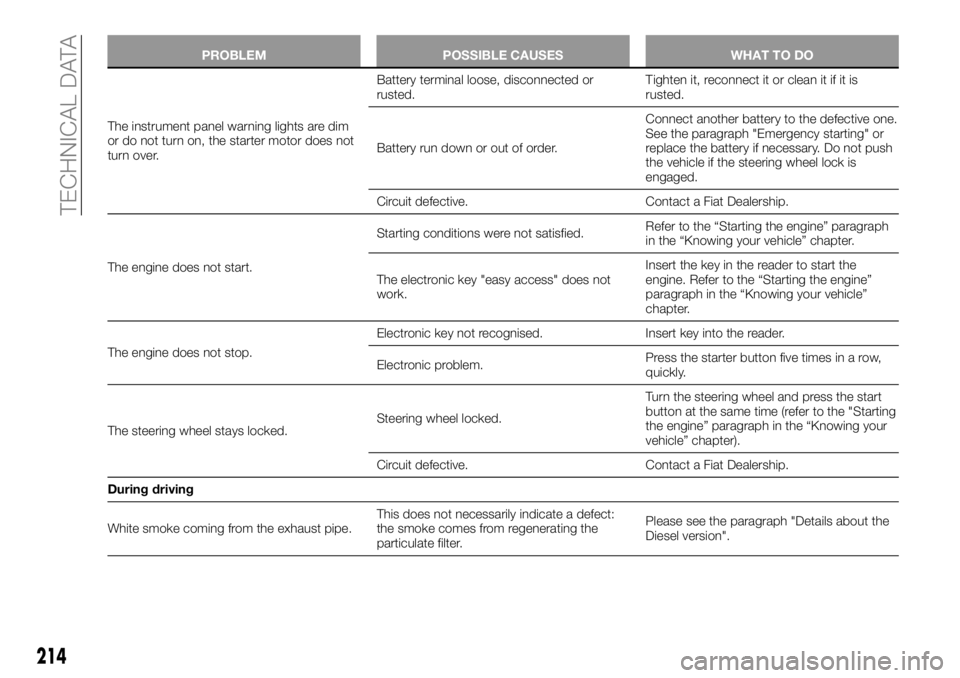
PROBLEM POSSIBLE CAUSES WHAT TO DO
The instrument panel warning lights are dim
or do not turn on, the starter motor does not
turn over.Battery terminal loose, disconnected or
rusted.Tighten it, reconnect it or clean it if it is
rusted.
Battery run down or out of order.Connect another battery to the defective one.
See the paragraph "Emergency starting" or
replace the battery if necessary. Do not push
the vehicle if the steering wheel lock is
engaged.
Circuit defective. Contact a Fiat Dealership.
The engine does not start.Starting conditions were not satisfied.Refer to the “Starting the engine” paragraph
in the “Knowing your vehicle” chapter.
The electronic key "easy access" does not
work.Insert the key in the reader to start the
engine. Refer to the “Starting the engine”
paragraph in the “Knowing your vehicle”
chapter.
The engine does not stop.Electronic key not recognised. Insert key into the reader.
Electronic problem.Press the starter button five times in a row,
quickly.
The steering wheel stays locked.Steering wheel locked.Turn the steering wheel and press the start
button at the same time (refer to the "Starting
the engine” paragraph in the “Knowing your
vehicle” chapter).
Circuit defective. Contact a Fiat Dealership.
During driving
White smoke coming from the exhaust pipe.This does not necessarily indicate a defect:
the smoke comes from regenerating the
particulate filter.Please see the paragraph "Details about the
Diesel version".
214
TECHNICAL DATA
Page 217 of 228
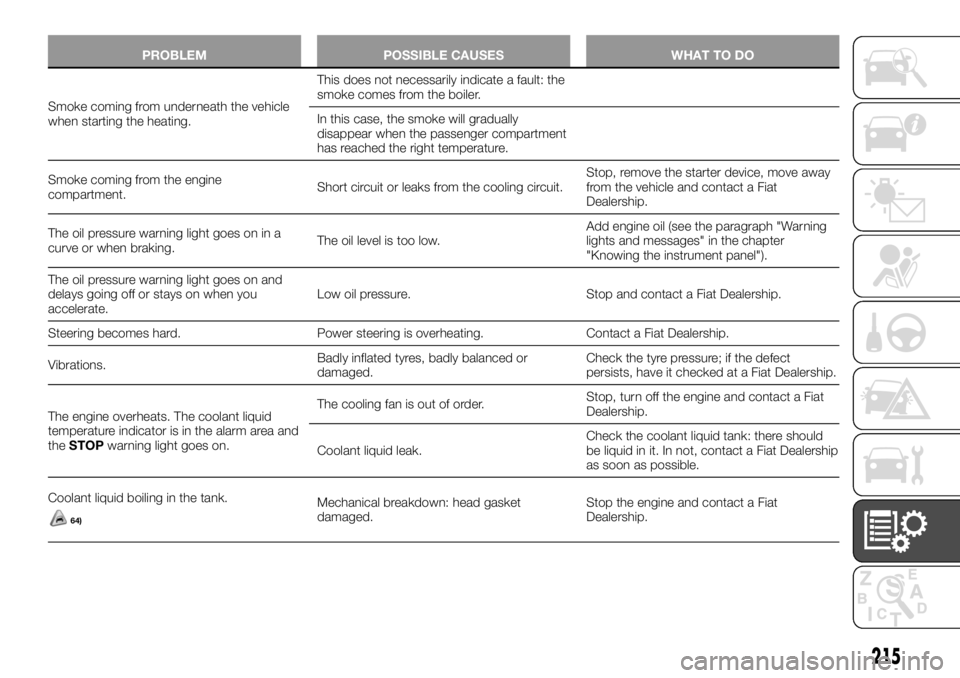
PROBLEM POSSIBLE CAUSES WHAT TO DO
Smoke coming from underneath the vehicle
when starting the heating.This does not necessarily indicate a fault: the
smoke comes from the boiler.
In this case, the smoke will gradually
disappear when the passenger compartment
has reached the right temperature.
Smoke coming from the engine
compartment.Short circuit or leaks from the cooling circuit.Stop, remove the starter device, move away
from the vehicle and contact a Fiat
Dealership.
The oil pressure warning light goes on in a
curve or when braking.The oil level is too low.Add engine oil (see the paragraph "Warning
lights and messages" in the chapter
"Knowing the instrument panel").
The oil pressure warning light goes on and
delays going off or stays on when you
accelerate.Low oil pressure. Stop and contact a Fiat Dealership.
Steering becomes hard. Power steering is overheating. Contact a Fiat Dealership.
Vibrations.Badly inflated tyres, badly balanced or
damaged.Check the tyre pressure; if the defect
persists, have it checked at a Fiat Dealership.
The engine overheats. The coolant liquid
temperature indicator is in the alarm area and
theSTOPwarning light goes on.The cooling fan is out of order.Stop, turn off the engine and contact a Fiat
Dealership.
Coolant liquid leak.Check the coolant liquid tank: there should
be liquid in it. In not, contact a Fiat Dealership
as soon as possible.
Coolant liquid boiling in the tank.
64)
Mechanical breakdown: head gasket
damaged.Stop the engine and contact a Fiat
Dealership.
215
Page 225 of 228
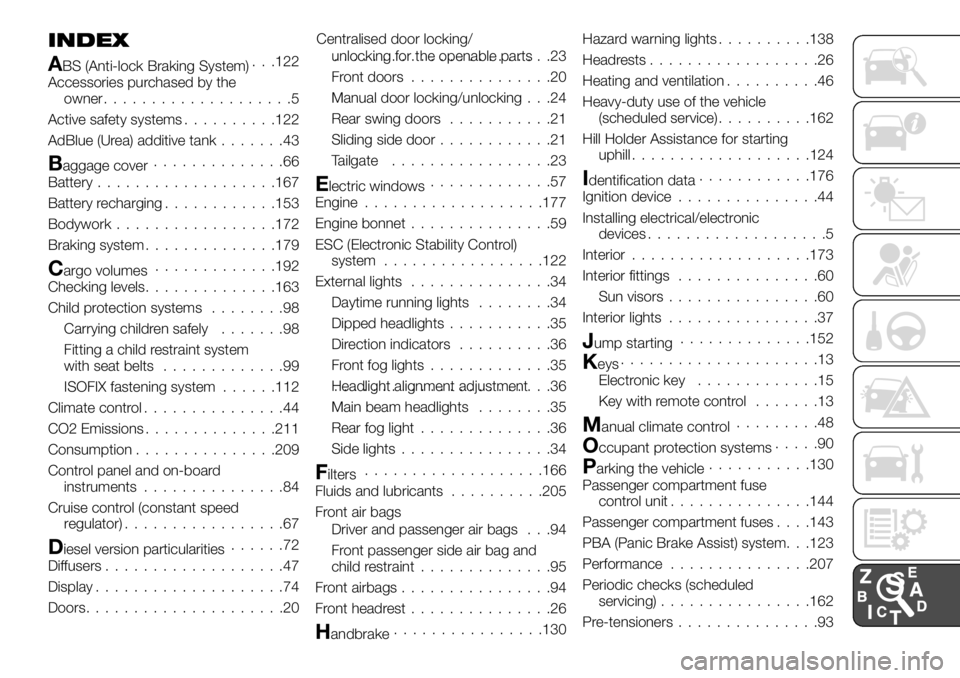
INDEX
ABS (Anti-lock Braking System). . .122
Accessories purchased by the
owner....................5
Active safety systems..........122
AdBlue (Urea) additive tank.......43
Baggage cover..............66
Battery...................167
Battery recharging............153
Bodywork.................172
Braking system..............179
Cargo volumes.............192
Checking levels..............163
Child protection systems........98
Carrying children safely.......98
Fitting a child restraint system
with seat belts.............99
ISOFIX fastening system......112
Climate control...............44
CO2 Emissions..............211
Consumption...............209
Control panel and on-board
instruments...............84
Cruise control (constant speed
regulator).................67
Diesel version particularities......72
Diffusers...................47
Display....................74
Doors.....................20Centralised door locking/
unlocking for the openable parts.......................23
Front doors...............20
Manual door locking/unlocking . . .24
Rear swing doors...........21
Sliding side door............21
Tailgate.................23
Electric windows.............57
Engine...................177
Engine bonnet...............59
ESC (Electronic Stability Control)
system.................122
External lights...............34
Daytime running lights........34
Dipped headlights...........35
Direction indicators..........36
Front fog lights.............35
Headlight alignment adjustment.......................36
Main beam headlights........35
Rear fog light..............36
Side lights................34
Filters...................166
Fluids and lubricants..........205
Front air bags
Driver and passenger air bags . . .94
Front passenger side air bag and
child restraint..............95
Front airbags................94
Front headrest...............26
Handbrake................130Hazard warning lights..........138
Headrests..................26
Heating and ventilation..........46
Heavy-duty use of the vehicle
(scheduled service)..........162
Hill Holder Assistance for starting
uphill...................124
Identification data............176
Ignition device...............44
Installing electrical/electronic
devices...................5
Interior...................173
Interior fittings...............60
Sun visors................60
Interior lights................37
Jump starting..............152
Keys.....................13
Electronic key.............15
Key with remote control.......13
Manual climate control.........48
Occupant protection systems.....90
Parking the vehicle...........130
Passenger compartment fuse
control unit...............144
Passenger compartment fuses. . . .143
PBA (Panic Brake Assist) system. . .123
Performance...............207
Periodic checks (scheduled
servicing)................162
Pre-tensioners...............93